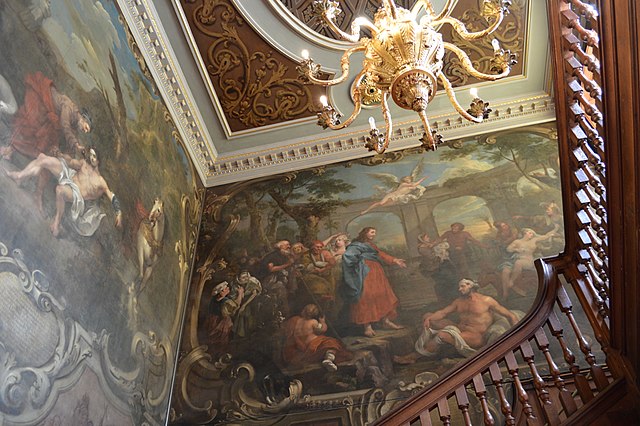One of William Hogarth’s most important but overlooked schemes, wrapped spectacularly around a stairwell at St Bartholomew’s Hospital in the City of London, will soon be fully accessible to the public following a campaign to restore the Grade I-listed north wing of the historic medical building. Hogarth’s vast canvases—The Pool of Bethesda and The Good Samaritan—created around 1735-37, will be restored as part of a project marking the hospital’s 900th anniversary.
“The building has been gently decaying for decades, with very limited public access. There is a little museum here but no regular access to the Hogarth Stair and [adjoining] Great Hall,” says Will Palin, the chief executive of Barts Heritage charity, which has embarked on a “pioneering programme of activity bringing heritage and health together”. Called Sharing Historic Barts, the project has been developed with “clinical teams in the hospital as well as patients, visitors and other cultural partners,” Palin adds.
The overall campaign has a £9.5m target and is now only £60,000 short, says Palin; crucially, it was boosted by a National Lottery Heritage Fund grant of £4.9m. “The work to the Hogarth Stair—both the paintings, its structure, its environmental controls and its lighting—is budgeted at approximately £400,000. The funding of this element of the project is being shared between the Heritage Fund and the Wolfson Foundation,” Palin says.
“The Hogarth Stair is not well-known and currently public access is very limited. Our project will introduce regular public access to the staircase for the first time in its history, both during the conservation work when visitors will be able to join special conservation tours, and after we reopen in 2025 when the staircase and Great Hall will be open to the public on regular days with new interpretation and a rich programme of cultural events and other activities,” he adds.
Hogarth, who was born in 1697 in Bartholomew Close near the hospital, was enflamed on learning that an Italian painter, Jacopo Amigoni, had been invited to paint the grand staircase. Hogarth subsequently stepped in and offered his services free of charge. The artist is known for his depictions of sozzled 18th-century London, but The Pool of Bethesda and The Good Samaritan are the artist’s first history paintings, depicting stories from the Bible at a huge scale, featuring figures around seven feet high.
Jacqueline Riding, the literary editor of The Art Newspaper and author of Hogarth: Life in Progress (Profile Books), says: “The works are not what you expect of Hogarth. In a single painting [The Pool of Bethesda], he combines two different things: grand-style history painting, as seen in the figure of Christ, and his typical observational style with representations of suffering and disease. It’s high and low art on the same canvas.
“The works show such ambition and real ingenuity. The crucial thing is that you need to move through the paintings, and up the staircase; the works reveal themselves gradually, like a theatre set. He probably painted part of them off-site in a large studio space in Covent Garden, possibly owned by his close friend George Lambert. The funding and restoration mean the paintings will become better known,” Riding says.
Meanwhile, the illustrator Adam Dant, who has been dubbed the “modern Hogarth”, has created a specially commissioned work marking the 900th anniversary of St Barts called Barts: 900 Years in 900 Stories, which will go on show in the north wing.
Dant scoured the hospital archives for details of historic sagas linked to the hospital; he also asked the public to tell their own Barts stories. “[The result] is an architectural panoramic drawing of the hospital and its precincts as the location for all manner of incident and activity. Scenes from the life of the hospital appear alongside events from the history of the neighbourhood, which is also home to the Smithfield meat market, the Old Bailey, Newgate Prison, Christ’s Hospital School and numerous caffs, haunted houses and rowdy taverns,” he says.
Dant has rejigged the street plan of this part of London to, he says, afford it an “unnatural symmetry” which parallels that of the human form and also refers to the courtyard scheme of the hospital designed by James Gibbs in the 1730s. He also has a very personal connection to the hospital.
“If you’d like to see more of St Barts than you bargained for then I’d recommend helping [pop star] Jarvis Cocker carry a hefty iron-framed piano down five flights of stairs! The work of the hospital’s hernia surgeons is swift and efficient,” he says. And what about the Hogarth comparison? “In the same way that Hogarth’s [stairwell] paintings have become an indistinguishable part of Barts itself, I equally hope that the 900 stories become an integral part of the hospital’s DNA and a part that will stand the test of time for the next 900 years.”



Comment here